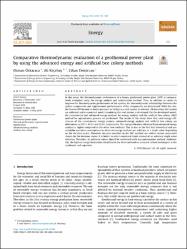| dc.contributor.author | Özkaraca, Osman | |
| dc.contributor.author | Keçebaş, Ali | |
| dc.contributor.author | Demircan, Cihan | |
| dc.date.accessioned | 2020-11-20T14:49:57Z | |
| dc.date.available | 2020-11-20T14:49:57Z | |
| dc.date.issued | 2018 | |
| dc.identifier.issn | 0360-5442 | |
| dc.identifier.issn | 1873-6785 | |
| dc.identifier.uri | https://doi.org/10.1016/j.energy.2018.05.095 | |
| dc.identifier.uri | https://hdl.handle.net/20.500.12809/1412 | |
| dc.description | 0000-0002-0964-8757 | en_US |
| dc.description | WOS: 000437073600015 | en_US |
| dc.description.abstract | In this study, the thermodynamic performance of a binary geothermal power plant (GPP) is comparatively evaluated using the exergy analysis and optimization method. Thus, in addition to routes to improve the thermodynamic performance of the system, the thermodynamic relationships between the system components and improvement performances of the components are determined. With this aim, the Sinem GPP located in Aydin province in Turkey as a real system is selected. All data from the system are collected and a numerical model simulating the real system is developed. On the developed model, the conventional and advanced exergy analyses for exergy analysis and the artificial bee colony (ABC) method for optimization process are performed. The results of the study show that total exergy efficiencies of the conventional exergy analysis, advanced exergy analysis and artificial bee colony are determined as 39.1%, 43.1% and 42.8%, respectively. The exergy efficiency obtained from advanced exergy analysis is higher compared to the other two methods. This is due to the fact that theoretical and unavoidable operation assumptions in advanced exergy analysis are arbitrary as a single value depending on the decision maker. However, decision variables in the ABC method are within certain constraints chosen by the decision maker. It is better to select constraint limits instead of an arbitrary single value selection. Therefore, its arbitrary values should be confirmed with any optimization method. Additionally, the highest exergy destruction identified in the three methods is occurred in heat exchangers as the condenser and vaporizer. (C) 2018 Elsevier Ltd. All rights reserved. | en_US |
| dc.description.sponsorship | Maren Geothermal Inc. | en_US |
| dc.description.sponsorship | The authors gratefully acknowledge the support provided for the present work by the Maren Geothermal Inc. and the personal support of, Mr. Ertan Turk. The authors are very grateful to the reviewers due their appropriate and constructive suggestions as well as their proposed corrections, which have been utilized in improving the quality of the paper. | en_US |
| dc.item-language.iso | eng | en_US |
| dc.publisher | Pergamon-Elsevier Science Ltd | en_US |
| dc.item-rights | info:eu-repo/semantics/closedAccess | en_US |
| dc.subject | Geothermal Power Plant | en_US |
| dc.subject | Thermal Performance Improvement | en_US |
| dc.subject | Optimization | en_US |
| dc.subject | Advanced Exergy Analysis | en_US |
| dc.subject | Artificial Bee Colony | en_US |
| dc.title | Comparative thermodynamic evaluation of a geothermal power plant by using the advanced exergy and artificial bee colony methods | en_US |
| dc.item-type | article | en_US |
| dc.contributor.department | MÜ, Teknoloji Fakültesi, Enerji Sistemleri Mühendisliği Bölümü | en_US |
| dc.contributor.institutionauthor | Özkaraca, Osman | |
| dc.contributor.institutionauthor | Keçebaş, Ali | |
| dc.identifier.doi | 10.1016/j.energy.2018.05.095 | |
| dc.identifier.volume | 156 | en_US |
| dc.identifier.startpage | 169 | en_US |
| dc.identifier.endpage | 180 | en_US |
| dc.relation.journal | Energy | en_US |
| dc.relation.publicationcategory | Makale - Uluslararası Hakemli Dergi - Kurum Öğretim Elemanı | en_US |


















